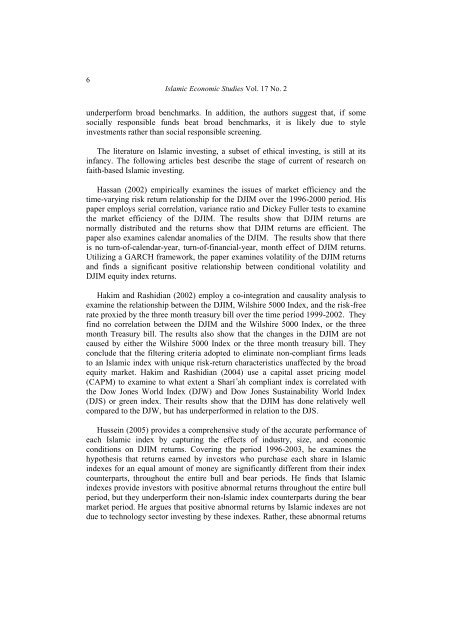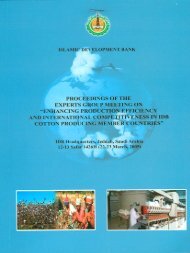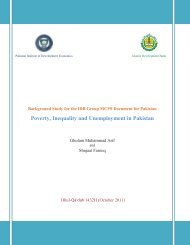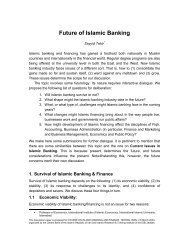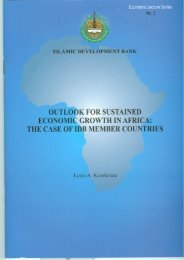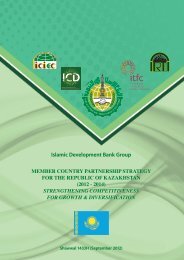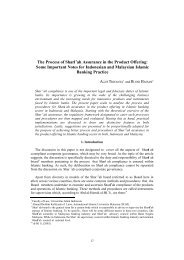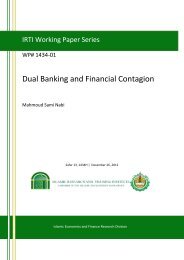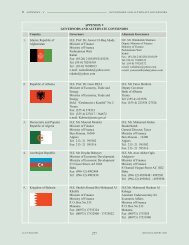faith-based ethical investing: the case of dow jones islamic ... - IRTI
faith-based ethical investing: the case of dow jones islamic ... - IRTI
faith-based ethical investing: the case of dow jones islamic ... - IRTI
- No tags were found...
You also want an ePaper? Increase the reach of your titles
YUMPU automatically turns print PDFs into web optimized ePapers that Google loves.
6Islamic Economic Studies Vol. 17 No. 2underperform broad benchmarks. In addition, <strong>the</strong> authors suggest that, if somesocially responsible funds beat broad benchmarks, it is likely due to styleinvestments ra<strong>the</strong>r than social responsible screening.The literature on Islamic <strong>investing</strong>, a subset <strong>of</strong> <strong>ethical</strong> <strong>investing</strong>, is still at itsinfancy. The following articles best describe <strong>the</strong> stage <strong>of</strong> current <strong>of</strong> research on<strong>faith</strong>-<strong>based</strong> Islamic <strong>investing</strong>.Hassan (2002) empirically examines <strong>the</strong> issues <strong>of</strong> market efficiency and <strong>the</strong>time-varying risk return relationship for <strong>the</strong> DJIM over <strong>the</strong> 1996-2000 period. Hispaper employs serial correlation, variance ratio and Dickey Fuller tests to examine<strong>the</strong> market efficiency <strong>of</strong> <strong>the</strong> DJIM. The results show that DJIM returns arenormally distributed and <strong>the</strong> returns show that DJIM returns are efficient. Thepaper also examines calendar anomalies <strong>of</strong> <strong>the</strong> DJIM. The results show that <strong>the</strong>reis no turn-<strong>of</strong>-calendar-year, turn-<strong>of</strong>-financial-year, month effect <strong>of</strong> DJIM returns.Utilizing a GARCH framework, <strong>the</strong> paper examines volatility <strong>of</strong> <strong>the</strong> DJIM returnsand finds a significant positive relationship between conditional volatility andDJIM equity index returns.Hakim and Rashidian (2002) employ a co-integration and causality analysis toexamine <strong>the</strong> relationship between <strong>the</strong> DJIM, Wilshire 5000 Index, and <strong>the</strong> risk-freerate proxied by <strong>the</strong> three month treasury bill over <strong>the</strong> time period 1999-2002. Theyfind no correlation between <strong>the</strong> DJIM and <strong>the</strong> Wilshire 5000 Index, or <strong>the</strong> threemonth Treasury bill. The results also show that <strong>the</strong> changes in <strong>the</strong> DJIM are notcaused by ei<strong>the</strong>r <strong>the</strong> Wilshire 5000 Index or <strong>the</strong> three month treasury bill. Theyconclude that <strong>the</strong> filtering criteria adopted to eliminate non-compliant firms leadsto an Islamic index with unique risk-return characteristics unaffected by <strong>the</strong> broadequity market. Hakim and Rashidian (2004) use a capital asset pricing model(CAPM) to examine to what extent a Shar ah compliant index is correlated with<strong>the</strong> Dow Jones World Index (DJW) and Dow Jones Sustainability World Index(DJS) or green index. Their results show that <strong>the</strong> DJIM has done relatively wellcompared to <strong>the</strong> DJW, but has underperformed in relation to <strong>the</strong> DJS.Hussein (2005) provides a comprehensive study <strong>of</strong> <strong>the</strong> accurate performance <strong>of</strong>each Islamic index by capturing <strong>the</strong> effects <strong>of</strong> industry, size, and economicconditions on DJIM returns. Covering <strong>the</strong> period 1996-2003, he examines <strong>the</strong>hypo<strong>the</strong>sis that returns earned by investors who purchase each share in Islamicindexes for an equal amount <strong>of</strong> money are significantly different from <strong>the</strong>ir indexcounterparts, throughout <strong>the</strong> entire bull and bear periods. He finds that Islamicindexes provide investors with positive abnormal returns throughout <strong>the</strong> entire bullperiod, but <strong>the</strong>y underperform <strong>the</strong>ir non-Islamic index counterparts during <strong>the</strong> bearmarket period. He argues that positive abnormal returns by Islamic indexes are notdue to technology sector <strong>investing</strong> by <strong>the</strong>se indexes. Ra<strong>the</strong>r, <strong>the</strong>se abnormal returns


